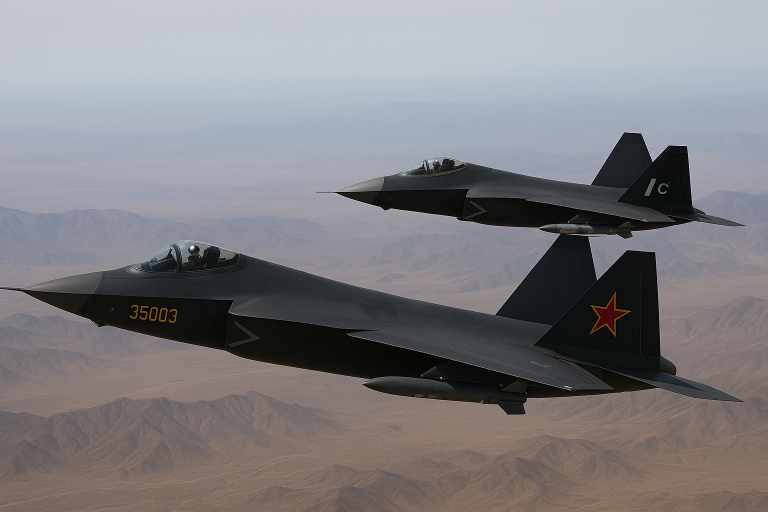China’s J-35 Offer to Pakistan: A Strategic Masterstroke
In a bold geopolitical move, China has reportedly offered its next-generation J-35 stealth fighter jets to Pakistan at an unprecedented 50% discount. This strategic decision has triggered widespread debate across defense and diplomatic circles in South Asia and beyond. The offer not only symbolizes deepening Sino-Pak military ties but also signals a direct challenge to India’s growing airpower capabilities, especially in the wake of its acquisition of French-made Rafale fighter jets.
The deal, if finalized, could significantly tilt the aerial balance of power in South Asia and reshape military dynamics in a region already teeming with strategic friction.
What Is the J-35? China’s Fifth-Generation Fighter Jet
The J-35, also known by its development name FC-31 Gyrfalcon, is China’s answer to the American F-35 Lightning II and Russia’s Su-57. It is being developed by Shenyang Aircraft Corporation, a subsidiary of the state-owned AVIC (Aviation Industry Corporation of China).
Key Technical Specifications
- Type: Fifth-generation, stealth multirole fighter
- Engines: Twin-engine design, currently WS-13E, future versions expected with WS-19
- Maximum Speed: Mach 1.8+
- Range: Approximately 1,200 miles (combat radius ~750 miles)
- Stealth Features: Low radar cross-section (RCS), internal weapons bay, radar-absorbing coating
- Avionics: AESA radar, helmet-mounted display, data fusion capabilities
- Armament:
- Internal bays and external hardpoints
- PL-15 BVRAAMs, PL-10 short-range missiles
- Precision-guided munitions
The J-35 is designed for both carrier-based and land-based operations, making it highly versatile. Its radar-evading stealth, modern avionics, and multirole functionality make it a serious contender in the global fighter jet arena.
How Does the J-35 Compare with India’s Rafale Jets?
India currently operates 36 Dassault Rafale jets from France, with plans to expand its fleet. The Rafale, though considered a 4.5-generation fighter, features highly advanced avionics, superior radar, and electronic warfare systems.
J-35 vs Rafale: Technical Comparison
Feature J-35 Rafale Generation 5th Gen 4.5 Gen Stealth Full stealth capabilities Limited stealth Engine Twin (WS-13E/WS-19) Twin (Snecma M88-2) Max Speed Mach 1.8+ Mach 1.8 Radar AESA RBE2 AESA Range ~1,200 miles ~1,900 miles Combat Radius ~750 miles ~1,050 miles Armament Compatibility Chinese weaponry NATO-standard weapons Avionics and Sensors Next-gen Chinese systems Proven French EW systems
While the Rafale excels in proven battlefield reliability and long-range capabilities, the J-35’s stealth and electronic warfare superiority give it an edge in modern aerial warfare, particularly in contested airspace scenarios.
Why Is China Offering a 50% Discount?
Deepening Pakistan-China Defense Ties
Pakistan has long been a strategic ally of China. Their military cooperation includes the JF-17 Thunder program, naval asset sharing, and defense training. The discounted J-35 offer strengthens this military partnership and helps counterbalance India’s growing military cooperation with the West.
Countering India’s Rafale Acquisition
India’s acquisition of Rafales has significantly improved its air superiority. China sees the J-35 deal as a means to neutralize the Rafale advantage and prevent strategic imbalance in the region.
Expanding China’s Defense Influence
Offering the J-35 at 50% discount, potentially pricing it under $40 million per unit, also serves China’s broader goal of establishing itself as a major global arms supplier. A successful deployment in Pakistan could boost future J-35 exports to countries in the Middle East and Africa.
Testing and Operational Data
Another likely reason behind this move is the need for real-world operational data. Pakistan’s rugged air defense environment and proximity to India make it an ideal theater to test the J-35’s performance under near-combat conditions. This helps China refine the jet while promoting its credibility as a combat-proven asset.
Regional Geopolitical Implications
Arms Race in South Asia
The J-35’s arrival in Pakistan could trigger an aerial arms race in the region. India might respond by fast-tracking its AMCA program (Advanced Medium Combat Aircraft) or seeking additional F-35s or Rafale variants.
Shift in Strategic Deterrence
With stealth aircraft in its arsenal, Pakistan would acquire enhanced first-strike and deep-strike capabilities, challenging India’s doctrinal superiority. This may prompt both nations to recalibrate their nuclear and conventional deterrence postures.
Pressure on U.S. and Western Allies
The move also challenges U.S. influence in South Asia. If Pakistan deploys the J-35 successfully, other U.S.-sanctioned or Western-isolated nations might consider buying Chinese fifth-gen fighters over Western counterparts.
Potential Challenges for Pakistan
Despite the discount, operational costs, pilot training, and maintenance infrastructure will remain significant hurdles. Moreover, integration into existing Pakistani air force structures could take time.
Additionally, Western sanctions or diplomatic pushback might follow, especially if the J-35 includes tech derived from reverse engineering Western systems—something often alleged against Chinese aerospace firms.
Conclusion: A New Era in South Asian Airpower
China’s offer to supply J-35 jets to Pakistan at a 50% discount is more than a business transaction—it’s a calculated move in the geopolitical chessboard of Asia. The stealth capabilities of the J-35, when placed alongside India’s Rafale fleet, mark a new chapter in South Asian aerial warfare—one defined not just by firepower but by stealth, technology, and strategic alliances.
The deal, if finalized, will not only redefine Pakistan’s air force capabilities but also challenge existing power equations in one of the world’s most volatile regions.

